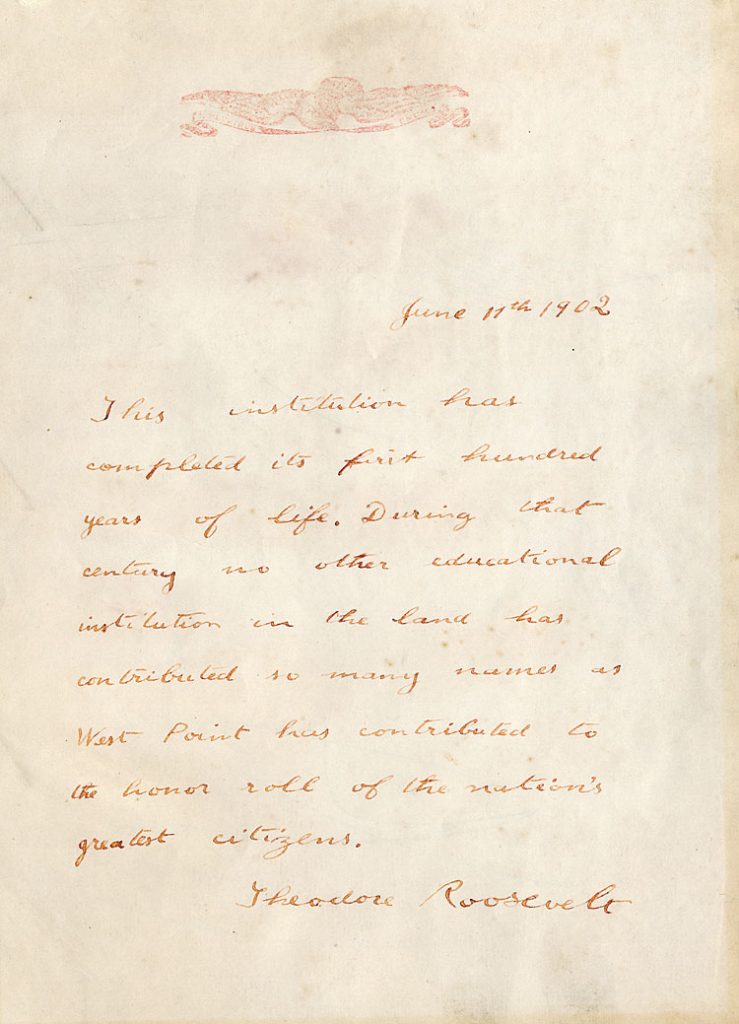At the Dawn of the 20th Century, Roosevelt Pays Tribute to West Point on Its Centennial

Quote from a Speech Given at the Commencement for the 100th Anniversary.
On March 16, 1802, President Thomas Jefferson signed legislation establishing the United States Military Academy. Colonel Sylvanus Thayer served as Superintendent from l8l7-l833. He upgraded academic standards, instilled military discipline and made civil engineering the foundation of the curriculum. For the first half century, West Point graduates were responsible for the construction...
On March 16, 1802, President Thomas Jefferson signed legislation establishing the United States Military Academy. Colonel Sylvanus Thayer served as Superintendent from l8l7-l833. He upgraded academic standards, instilled military discipline and made civil engineering the foundation of the curriculum. For the first half century, West Point graduates were responsible for the construction of the bulk of the nation’s initial railway lines, bridges, harbors and roads.
West Point has produced many of the nation’s most significant military leaders. They gained experience and national recognition during the Mexican and Indian wars and dominated the highest ranks on both sides during the Civil War. Academy graduates included Ulysses S. Grant, Robert E. Lee, William T. Sherman and Stonewall Jackson.
After his election as President, William McKinley appointed Theodore Roosevelt assistant secretary of the navy in 1897. Roosevelt resigned his post in May 1898 to take command of the First U.S. Volunteer Cavalry, also known as the Rough Riders. On July 1, 1898, TR led the right wing of the attack on San Juan Hill. At the conclusion of the war, mainly because of his war record and flair, Roosevelt was almost immediately elected governor of New York. Later chosen by McKinley to run for Vice President, he took that office in 1901. TR would only serve for a few months, taking the presidency after McKinley’s assassination in September 1901.
A military man, nationalist, and outdoorsman, Roosevelt established the power of the American presidency as no other president had, taking American initiatives onto an international scale. Though not a West Pointer himself, he served with many in Cuba, and no one knew better than he the contributions its graduates had made to the nation.
In June 1902, for one week, graduates and leaders from around the world came to celebrate West Point’s 100th anniversary and to look to the future. President Roosevelt was invited to sound the keynote of the event, and on June 11 delivered the centennial speech at the Commencement for the class of that year. As The New York Times wrote the next day, “President Roosevelt’s train arrived at 9:30 o’clock. For hours the crowds had been gathering on the parade ground and along the walks leading down the steep hill to the railroad station. When the train came in sight, the path leading up to the academy grounds became so crowded that a detachment of soldiers, assisted by the sentinels at intervals along the way had to resort to strenuous measures to force the crowd back. Behind the president were grouped nearly a hundred military men, distinguished civilians, foreigners, and national and metropolitan detectives.”
Roosevelt’s speech was a moving tribute to the Academy in which he remembered the past while looking to the future, speaking of his own experience, the cadets’ service, and dwelling on the changing face of warfare. It was printed and re-printed, and so defined the role of West Point that it can still be found on the military academy website. This following is a quotation from the most often-quoted portion of TR’s speech, likely written out for publication. It is the only signed speech segment of his as president that we can recall seeing.
Autograph Quotation Signed, June 11th 1902. “This institution has completed its first hundred years of life. During that century no other education institution in the land has contributed so many names as West Point has contributed to the honor roll of the nation’s greatest citizens. Theodore Roosevelt.” On paper of famed New York stationer Corlies & Macy, Co., with an eagle holding the e pluribus unum banner of the presidential seal.
Roosevelt’s confidence in West Point was well placed. At the turn of the century it was on the verge of generating a new generation of American leaders to fight in World War I and II, including Eisenhower, MacArthur, Bradley, Arnold, Clark, Patton, Stilwell and Wainwright.

Frame, Display, Preserve
Each frame is custom constructed, using only proper museum archival materials. This includes:The finest frames, tailored to match the document you have chosen. These can period style, antiqued, gilded, wood, etc. Fabric mats, including silk and satin, as well as museum mat board with hand painted bevels. Attachment of the document to the matting to ensure its protection. This "hinging" is done according to archival standards. Protective "glass," or Tru Vue Optium Acrylic glazing, which is shatter resistant, 99% UV protective, and anti-reflective. You benefit from our decades of experience in designing and creating beautiful, compelling, and protective framed historical documents.
Learn more about our Framing Services








































































































